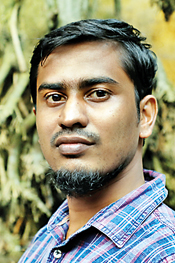Capturing complicated interplay between humans and nature
 Rupaneethan Pakkiyarajah’s landscapes, at first glance, seem to reflect the landmined, rusty bloodstained North (or it could be the gray, post-revolutionary Russia or even the Apocalypse); while his object drawings are full of queer crawling vegetation and fungi- like the work of a botanist become faerie artist. But that is before you dip into their deeper sophistication: “so sophisticated,” says curator Shanth Fernando “it is spiritual and also surrealistic, emotional, sensitive”.
Rupaneethan Pakkiyarajah’s landscapes, at first glance, seem to reflect the landmined, rusty bloodstained North (or it could be the gray, post-revolutionary Russia or even the Apocalypse); while his object drawings are full of queer crawling vegetation and fungi- like the work of a botanist become faerie artist. But that is before you dip into their deeper sophistication: “so sophisticated,” says curator Shanth Fernando “it is spiritual and also surrealistic, emotional, sensitive”. The 30-year-old artist’s work will be on exhibition and sale at the Paradise Road Gallery Café this April. It will be a chance to get to know this almost shy being who is really an amalgamation of traditional art and the most modern- his grandfather having been a practitioner of Koothu (the Tamil art of storytelling the epics through song, dance and music) and himself a product of the University of Jaffna where he specialized in sculpture.
Batticaloa-born, Rupaneethan is today a teacher of sculpture and drawing at the Swami Vipulananda Institute of Aesthetic Studies of the Eastern University of Sri Lanka.
At Jaffna University Rupaneethan was inspired by his teachers who were the leaders of the contemporary art scene in Sri Lanka, from Dr. T. Shanathanan, Muhanned Cader to Professor Chandraguptha Thenuwara and Pradeep Talwatte.

Rupaneethan Pakkiyarajah. Pix by M.A. Pushpa Kumara
At an early point of his career Rupaneethan began experimenting with rubber as a medium, manipulating it to represent the inside and outside of the skin. To him, sculpture made from rubber can spark a conversation on ‘boundaries’; such as those between negative and positive spaces; or between masculinity and femininity.
Rubber moulds are soft, flexible, and generally serve to reproduce artwork but are rarely featured in it. Where others saw feminized form, Rupaneethan saw potential. At university, he turned to soft rubber materials to think of his own skin in the face of severe bullying. He felt that bullying encouraged aggressive masculinity and consolidated power hierarchies, and its effects left imprints on his own skin. He found rubber and other materials could reflect his own pain.
Ever since, through expanded ideas of sculpture, he seeks to reflect on his own self-construction and the body as an abstract conception in an ecological context. These experiences have led Rupaneethan to think about the landscape and violence that surrounded him.
He believes that by acknowledging our interconnectedness and how we are moulded by the environment around us, we can use art to dismantle the “power hierarchies that are destroying both societies and nature.”
In 2016 he developed these experiments with rubber moulds in his degree show at the University of Jaffna, titled ‘My Soft Skin’. As a student in the North he witnessed transformations in the landscape caused by the war and those who tried to dominate the land, how the land bore the effects of these struggles. He also saw how his own colleagues’ and friends’ own skin was scarred by conflict. He found that through expanded ideas of sculpture, he could blur boundaries between the body and the land to make portraits of himself and the landscapes that surrounded him, and think about the borders between the two.
There is a complicated interplay between humans and nature that envelops these relationships between people. Rupaneethan observes the human-made interweaving of relationships created by electrical and telephone wires crisscrossing the land – linking everything from paddy fields and gardens, huts, houses and apartments, to public buildings and monuments, meandering through churches, mosques and temples and snaking through ponds, rivers and lagoons. In the decade since the civil war ended, such infrastructural connections have increased exponentially.
At the same time, and as a partial consequence of even greater human connectivity, forests have been significantly destroyed.
The 2019 Easter bombings heightened communal anxieties and borders between communities are becoming more visible than ever before. People seek safety among those of their own identity, leaving the land to become fractured again.
More recently COVID-19 has compounded distances between individual human beings, and yet, the wires of connectivity remain. Seeing himself as accountable to this national community, his work observes how landscape can embody caste, class, race, and religious identities of people; but also, how landscapes can offer space for difference and interdependency between people, and the possibility for collective identity where connections can be forged across borders and divisions.
(Rupaneethan Pakkiyarajah’s exhibition is on from April 1-28, from 10 a.m. till midnight every day at the Paradise Road Galleries)



